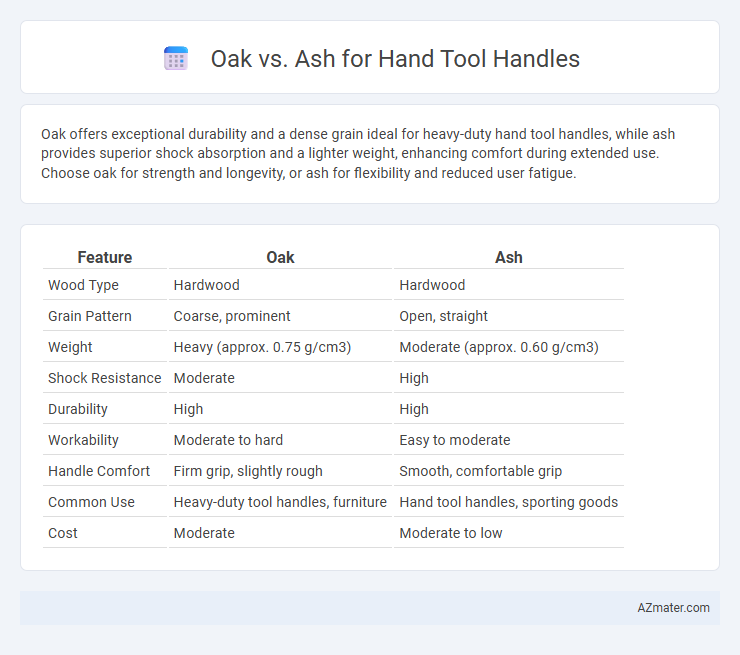Oak offers exceptional durability and a dense grain ideal for heavy-duty hand tool handles, while ash provides superior shock absorption and a lighter weight, enhancing comfort during extended use. Choose oak for strength and longevity, or ash for flexibility and reduced user fatigue.
Table of Comparison
| Feature | Oak | Ash |
|---|---|---|
| Wood Type | Hardwood | Hardwood |
| Grain Pattern | Coarse, prominent | Open, straight |
| Weight | Heavy (approx. 0.75 g/cm3) | Moderate (approx. 0.60 g/cm3) |
| Shock Resistance | Moderate | High |
| Durability | High | High |
| Workability | Moderate to hard | Easy to moderate |
| Handle Comfort | Firm grip, slightly rough | Smooth, comfortable grip |
| Common Use | Heavy-duty tool handles, furniture | Hand tool handles, sporting goods |
| Cost | Moderate | Moderate to low |
Introduction: Oak vs Ash for Hand Tool Handles
Oak and ash are popular hardwood choices for hand tool handles due to their strength and durability. Oak offers a dense grain structure that provides excellent impact resistance, making it ideal for heavy-duty applications. Ash features a lighter weight and greater flexibility, which enhances shock absorption and reduces user fatigue during extended use.
Key Characteristics of Oak Wood
Oak wood is prized for hand tool handles due to its exceptional density and strength, providing durability and resistance to wear. Its coarse grain structure offers excellent shock absorption, which reduces vibration during use, enhancing user comfort and control. High tannin content in oak also lends natural resistance to moisture and decay, ensuring longevity in demanding work environments.
Key Characteristics of Ash Wood
Ash wood stands out for hand tool handles due to its exceptional shock resistance and flexibility, making it ideal for absorbing impact during use. Its straight grain and coarse texture provide a comfortable grip while maintaining durability under stress. The wood's moderate density balances strength with lightweight properties, enhancing user control and reducing fatigue.
Strength and Durability Comparison
Oak offers superior strength and density, making it highly resistant to impact and wear, ideal for heavy-duty hand tool handles. Ash is known for its excellent shock absorption and flexibility, reducing user fatigue while maintaining durability under repetitive stress. Both woods provide durability, but oak excels in hardness and longevity for tough applications, whereas ash prioritizes resilience and comfort.
Shock Absorption and Flexibility
Oak offers superior shock absorption due to its dense and sturdy grain structure, making it ideal for hand tool handles that require durability. Ash provides greater flexibility and resilience, reducing user fatigue by effectively damping vibrations during use. When choosing between oak and ash, consider oak for heavy-duty tasks and ash for tools requiring enhanced comfort and reduced impact strain.
Weight and Workability Differences
Oak hand tool handles are heavier due to their dense, tightly-grained hardwood structure, providing excellent durability and shock resistance. Ash handles are lighter with an open grain, offering superior workability and flexibility, which reduces user fatigue during extended tasks. The weight difference significantly affects tool balance, with oak favoring heavy-duty applications and ash preferred for precision and comfort.
Grain Structure and Splinter Resistance
Oak features a prominent open grain structure with large pores, which can lead to higher splintering risk but offers excellent durability and shock resistance for hand tool handles. Ash has a tighter, more uniform grain with better flexibility and superior splinter resistance, making it ideal for ergonomically demanding tools. The dense, interlocked fibers of ash contribute to enhanced comfort and reduced hand fatigue during extended use.
Weather Resistance and Longevity
Oak demonstrates superior weather resistance compared to ash due to its dense grain and natural tannins, which help prevent moisture absorption and decay, making it ideal for outdoor hand tool handles. Ash, while lighter and more flexible, tends to absorb water more readily, increasing the risk of swelling and reducing longevity in harsh weather conditions. Consequently, oak handles provide enhanced durability and long-lasting performance in environments exposed to moisture and fluctuations in temperature.
Cost and Material Availability
Oak hand tool handles generally offer greater durability and resistance to wear, but they tend to be more expensive due to slower growth rates and higher processing costs. Ash, being more abundant and faster-growing, provides a cost-effective alternative with good shock resistance, making it readily available in most markets. Material availability of ash ensures consistent supply, while oak's premium quality justifies its higher price for specialized hand tool applications.
Choosing the Right Wood: Oak or Ash?
Oak offers exceptional durability and a dense grain structure, making it ideal for hand tool handles that require high impact resistance and longevity. Ash provides superior shock absorption with a lighter weight, enhancing user comfort and reducing fatigue during extended use. Selecting between oak and ash depends on prioritizing durability and strength versus flexibility and comfort for the specific hand tool application.

Infographic: Oak vs Ash for Hand Tool Handle
 azmater.com
azmater.com